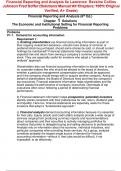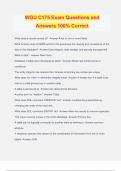Financial Reporting and Analysis 6e Lawrence Revsine Collins
Johnson Fred Soffer (Solutions Manual All Chapters, 100% Original
Verified, A+ Grade)
Financial Reporting and Analysis (6th Ed.)
Chapter 1 Solutions
The Economic and Institutional Setting for Financial Reporting
Problems
Problems
P1-1. Demand for accounting information
Requirement 1:
a) Existing shareholders use financial accounting information as part of
their ongoing investment decisions—should more shares of common or
preferred stock be purchased, should some shares be sold, or should current
holdings be maintained? Financial statements help investors assess the
expected risk and return from owning a company’s common and preferred
stock. They are especially useful for investors who adopt a “fundamental
analysis” approach.
Shareholders also use financial accounting information to decide how to vote
on corporate matters like who should be elected to the board of directors,
whether a particular management compensation plan should be approved,
and if the company should merge with or acquire another company. Acting on
behalf of shareholders, the Board of Directors hires and fires the company’s
top executives. Financial statement information helps shareholders and the
board assess the performance of company executives. Dismissals of top
executives often occur following a period of deteriorating financial
performance.
b) Financial statement information helps prospective (potential) investors
identify stocks consistent with their preferences for risk, return, dividend yield,
and liquidity. Here too, financial statements are especially useful for those
investors that adopt a “fundamental approach.”
c) Financial analysts demand accounting information because it is essential
for their jobs. Equity (stock) and credit (debt) analysts provide a wide range of
services ranging from producing summary reports and recommendations
about companies and their securities to actively managing portfolios for
investors that prefer to delegate buying and selling decisions to professionals.
Analysts rely on information about the economy, individual industries, and
particular companies when providing these services. As a group, analysts
constitute probably the largest single source of demand for financial
accounting information—without it, their jobs would be difficult, if not
impossible, to do effectively.
1-1
Copyright © 2015 McGraw-Hill Education. All rights reserved. No reproduction or distribution without the prior written consent of McGraw-Hill
Education.
, d) Managers demand financial accounting information to help them carry out
their responsibilities to shareholders. Financial accounting information is used
by managers to assess the profitability and health of individual business units
and the company as a whole. Their compensation often depends on financial
statement numbers like earnings per share, return on equity, return on capital
employed, sales growth, and so on. Managers often use a competitor’s
financial statements to benchmark profit performance, cost structures,
financial health, capabilities, and strategies.
e) Current employees demand financial accounting information to monitor
payouts from profit-sharing plans and employee stock ownership plans
(ESOPs). Employees also demand financial accounting information to gauge
a company’s long-term viability and the likelihood of continued employment,
as well as payouts under company-sponsored pension and health-care
programs. Unionized employees have other reasons to demand financial
statements, and those are described in Requirement 2 which follows.
f) Lenders use financial accounting information to help determine the
principal amount, interest rate, term, and collateral required on loans they
make. Loan agreements often contain covenants that require a company to
maintain minimum levels of various accounting ratios. Because covenant
compliance is measured by accounting ratios, lenders demand financial
accounting information so they can monitor the borrower’s compliance with
loan terms.
g) Suppliers demand financial accounting information about current and
potential customers to determine whether to grant credit, and on what terms.
The incentive to monitor a customer’s financial condition and operating
performance does not end after the initial credit decision. Suppliers monitor
the financial condition of their customers to ensure that they are paid for the
products, materials, and services they sell.
h) Debt-rating agencies like Moody’s or Standard & Poor’s help lenders and
investors assess the default risk of debt securities offered for sale. Rating
agencies need financial accounting information to evaluate the level and
volatility of the company’s expected future cash flows.
i) Taxing authorities (one type of government regulatory agency) use
financial accounting information as a basis for establishing tax policies.
Companies or industries that appear to be earning “excessive” profits may be
targeted for special taxes or higher tax rates. Keep in mind, however, that
taxing authorities in the United States and many other countries are allowed
to set their own accounting rules. These tax accounting rules, and not GAAP,
determine a company’s taxable income.
1-2
Copyright © 2015 McGraw-Hill Education. All rights reserved. No reproduction or distribution without the prior written consent of McGraw-Hill
Education.
, Other government agencies are often customers of the company. In this
setting, financial information can serve to help resolve contractual disputes
between the company and its customer (the agency) including claims that the
company is earning excessive profits. Financial accounting information can
also be used to determine if the company is financially strong enough to
deliver the ordered goods and services.
Financial accounting information is also used in rate-making deliberations
and monitoring of regulated monopolies such as public utilities.
Requirement 2:
Student responses will vary, but examples are shareholder activist groups
(CalPERS), labor unions, and customers.
Shareholder activist groups demand financial accounting information to
help determine how well the company’s current management team is
doing, and whether the managers are being paid appropriately.
Labor unions demand financial accounting information to help formulate or
improve their bargaining positions with employer companies. Union
negotiators may use financial statements showing sustained or improved
profitability as evidence that employee wages and benefits should be
increased.
Customers demand financial accounting information to help determine if
the company will be able to deliver the product on a timely basis and
provide product support after delivery.
P1-2. Incentives for voluntary disclosure
Requirement 1:
a) Companies compete with one another for financial capital in debt and
equity markets. They want to obtain financing at the lowest possible cost. If
investors are unsure about the “quality” of a company’s debt and equity
securities—the risks and returns of investment—they will demand a lower
price (higher rate of return) than would otherwise be the case. Companies
have incentives to voluntarily provide information that allows investors and
lenders to assess the expected risk and return of each security. Failing to do
so means lenders may charge a higher rate of interest for the added
informational risk, and stock investors will give the company less cash for its
common or preferred stock.
b) Companies compete with one another for talented managers and
employees. Information about a company’s past financial performance, its
1-3
Copyright © 2015 McGraw-Hill Education. All rights reserved. No reproduction or distribution without the prior written consent of McGraw-Hill
Education.
, current health, and its prospects is useful to current and potential employees
who are interested in knowing about long-term employment opportunities,
present and future salary and benefit levels, and advancement opportunities
at the company. To attract the best talent, companies have incentives to
provide financial information that allows prospective managers and
employees to assess the risk and potential rewards of employment.
c) Companies and their managers also compete with one another in the
“market for corporate control.” Here companies make offers to buy or merge
with other companies. Managers of companies that are the target of a friendly
merger or tender offer—a deal they want done—have incentives to disclose
information that raises the bid price. Examples include forecasts of increased
sales and earnings growth. Managers of companies that are the target of
unfriendly (hostile) offers—deals they don’t want done—have incentives to
disclose information that shows the company is best left in the hands of
current management. Hostile bidders often put a different spin on the same
financial information, arguing that it shows just how poorly current
management has run the company.
Requirement 2:
Student responses will vary, but here are some examples:
Competitive forces from within the industry (i.e., other firms in the industry
are voluntarily disclosing information about order backlogs, customer
turnover, or other key performance indicators).
Demands by financial analysts for expanded or increased disclosure by
the firm.
Demands by shareholder activist groups such as CalPERS.
Demands by debt rating agencies such as Moody’s and Standard &
Poor’s.
Pressure from governmental regulatory agencies such as the Securities
and Exchange Commission. Firms may believe that disclosing certain
information voluntarily may prevent the Securities and Exchange
Commission from mandating more detailed disclosures at a later date.
Demands from institutional investors (e.g., mutual funds, pension funds,
insurance companies, etc.) that hold the company’s securities.
Requirement 3:
The following examples are press release items that could be disclosed
voluntarily: forecasts of current quarter or annual earnings; forecasts of
1-4
Copyright © 2015 McGraw-Hill Education. All rights reserved. No reproduction or distribution without the prior written consent of McGraw-Hill
Education.





